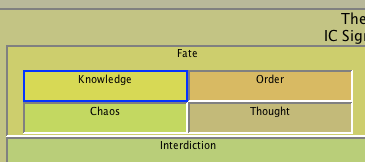I feel like I should know this but I’m going to ask anyway.
In the theme browser as we work through the order of elements when composing a scene, (1) what significance does the placement of elements in the quad have and (b, always wanted to do that), what significance does their order have.
For example, the PSR lays this out as Knowledge, Thought, Order, Chaos
Obviously that’s two dynamic pairs…oh wait, thought happening…so that’s a Hairpin, right? So this is where you work with the other patterns like the Z pattern and the U turn? Hmmm a slide-bump-slide…okay, I see…

Man this is nerve wracking when you’re trying to line up all the details and remember everything you read in the book. I know it will get easier.
It is absolutely fascinating, how the theme elements separate from the character elements. I wish I understood the relationship between them a bit better.

